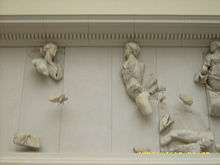Theia
| Theia | |
|---|---|
| Titaness of sight and the shining light of the clear blue sky | |
| Member of the Titans | |
 In the frieze of the Great Altar of Pergamon (Berlin), the goddess who fights at Helios' back is conjectured to be Theia[1] | |
| Other names | Euryphaessa, Aethra (probably) |
| Personal information | |
| Consort | Hyperion |
| Offspring | Helios, Selene, Eos |
| Parents | Gaia and Uranus |
| Siblings |
|
In Greek mythology, Theia (/ˈθiːə/; Ancient Greek: Θεία, translit. Theía, also rendered Thea or Thia), also called Euryphaessa "wide-shining", is a Titaness. Her brother/consort is Hyperion, a Titan and god of the sun, and together they are the parents of Helios (the Sun), Selene (the Moon), and Eos (the Dawn).
Etymology
The name Theia alone means simply "goddess" or "divine"; Theia Euryphaessa (Θεία Εὐρυφάεσσα) brings overtones of extent (εὐρύς, eurys, "wide", root: εὐρυ-/εὐρε-) and brightness (φάος, phaos, "light", root: φαεσ-).
Mythology
Earliest account
Hesiod's Theogony gives her an equally primal origin, said to be the eldest daughter of Gaia (Earth) and Uranus (Sky).[2] Robert Graves also relates that later Theia is referred to as the cow-eyed Euryphaessa who gave birth to Helios in myths dating to Classical Antiquity.[3][4]
Later myths
Once paired in later myths with her Titan brother Hyperion as her husband, "mild-eyed Euryphaessa, the far-shining one" of the Homeric Hymn to Helios, was said to be the mother of Helios (the Sun), Selene (the Moon), and Eos (the Dawn).
Pindar praises Theia in his Fifth Isthmian ode:
"Mother of the Sun, Theia of many names, for your sake men honor gold as more powerful than anything else; and through the value you bestow on them, o queen, ships contending on the sea and yoked teams of horses in swift-whirling contests become marvels."
She seems here a goddess of glittering in particular and of glory in general, but Pindar's allusion to her as "Theia of many names" is telling, since it suggests assimilation, referring not only to similar mother-of-the-sun goddesses such as Phoebe and Leto, but perhaps also to more universalizing mother-figures such as Rhea and Cybele.
Genealogy
Theia in the sciences
Theia's mythological role as the mother of the Moon goddess Selene is alluded to in the application of the name to a hypothetical planet which, according to the giant impact hypothesis, collided with the Earth, resulting in the Moon's creation.
Theia's alternate name Euryphaessa has been adopted for a species of Australian leafhoppers Dayus euryphaessa (Kirkaldy, 1907).
A Theia figure has been found at the Necropolis of Cyrene.[10]
See also
Notes
- ↑ M.M. Honan, Guide to the Pergamon Museum, Berlin 1904, etc.
- ↑ Hesiod, Theogony, 132.
- ↑ Graves, Robert, The Greek Myths, 42.a
- ↑ Hesiod, Theogony 371; of "cow-eyed, Karl Kerenyi observes that "these names recall such names as Europa and Pasiphae, or Pasiphaessa—names of moon-goddesses who were associated with bulls. In the mother of Helios we can recognize the moon-goddess, just as in his father Hyperion we can recognise the sun-god himself" (Kerenyi, The Gods of the Greeks, 1951, p. 192).
- ↑ Hesiod, Theogony 132–138, 337–411, 453–520, 901–906, 915–920; Caldwell, pp. 8–11, tables 11–14.
- ↑ Although usually the daughter of Hyperion and Theia, as in Hesiod, Theogony 371–374, in the Homeric Hymn to Hermes (4), 99–100, Selene is instead made the daughter of Pallas the son of Megamedes.
- ↑ According to Hesiod, Theogony 507–511, Clymene, one of the Oceanids, the daughters of Oceanus and Tethys, at Hesiod, Theogony 351, was the mother by Iapetus of Atlas, Menoetius, Prometheus, and Epimetheus, while according to Apollodorus, 1.2.3, another Oceanid, Asia was their mother by Iapetus.
- ↑ According to Plato, Critias, 113d–114a, Atlas was the son of Poseidon and the mortal Cleito.
- ↑ In Aeschylus, Prometheus Bound 18, 211, 873 (Sommerstein, pp. 444–445 n. 2, 446–447 n. 24, 538–539 n. 113) Prometheus is made to be the son of Themis.
- ↑ Joyce Reynolds and James Copland Thorn (2005). "Cyrene's Thea figure discovered in the Necropolis". Libyan Studies. doi:10.1017/S0263718900005525.
References
- Smith, William; Dictionary of Greek and Roman Biography and Mythology, London (1873). "Theia"